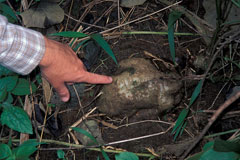Kudzu vine, Pueraria montana lobata
There is a vine out there that can take down hydro poles, engulf buildings, and literally smother forests in the US. Here in the UK it is likely less invasive (because we have an unusual climate, with the wet winters and cool summers), but we need to monitor plants carefully, so they don’t get out of hand.
Kudzu roots can survive winter but if the temperatures dip to -20°C then this can kill the plant’s root system. If it survives winter, it makes its appearance in spring.
Kudzu, has been a popular food in Japan and China for thousands of years. The edible parts of the kudzu plant are the leaves, vine tips, flower blossoms, and roots.
 The root can be eaten cooked. The root can be up to 1.8 metres long and has been known to weigh 35 kilos or more.
The root can be eaten cooked. The root can be up to 1.8 metres long and has been known to weigh 35 kilos or more.
The root contains about 10% starch, this can be extracted and used as a crispy coating in deep fried foods, or for thickening soups etc.
The tuberous roots are dehydrated and pulverized, and it is this starchy kudzu powder that is used for cooking in myriad ways from thickening soups and sauces to batter for foods to be deep-fried.
It can also be made into noodles, or like agar or gelatine is used as a gelling agent for salads.
The flowers can be cooked or made into pickles.
In the early spring and throughout the growing season, harvest the very end of an established kudzu vine where the new growth is forming small shoots and young leaves. Young leaves and vine tips are tender enough for most culinary purposes including in salads. A very nutritious food, the fresh young shoots taste like a cross between a bean and a pea.
The older, larger leaves are good for dolmades (stuffed leaves).
Kudzu Health Benefits: there is scientific evidence that claims it contains constituents that help prevent cancer.
The isoflavones in kudzu also help to fight alcoholism. Kudzu may decrease peak alcohol levels.
Kudzu also helps in other ways such as:
- Anti-bacterial
- Anti-inflammatory
- Antioxidant
- Anti-thrombotic
- Cardiovascular effects: Early preclinical and animal research suggests kudzu has a protective effect against myocardial ischemia and may increase cardiac function.
- Osteoporotic effects: In animal studies, kudzu increased bone mineral density.
